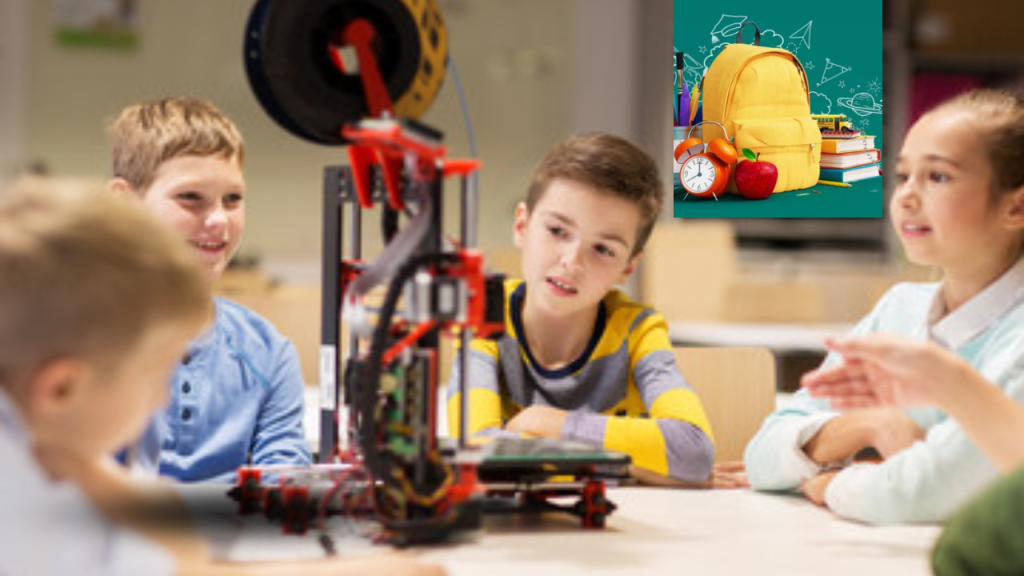3D printing is an innovative technology has the power to revolutionize learning by supporting different learning styles, improving collaboration and critical thinking skills, and allowing students to move from consuming information to creating and thinking on a deeper level.
With 3D printing, students can design and create tangible objects, fostering creativity, problem-solving skills, independent thinking, and preparing them for the future.
Discover the benefits of 3D printing in educational settings and unlock creativity today!
Enhancing Learning Experiences
3D printing enhances learning by providing hands-on experiences with physical items and encourages the design and modification of 3D printed objects. This technology has revolutionized education by allowing students to explore and create in a tangible way. In schools, 3D printing is used to teach various subjects, from science and math to art and design. It allows educators to engage students in interactive lessons that promote critical thinking and problem-solving skills.
- By incorporating 3D printing into the curriculum, students can take a more active role in their learning. They can design and create their own objects, bringing their ideas to life. This hands-on approach fosters creativity and encourages independent thinking.
- Students can experiment with different designs, test their prototypes, and make modifications based on their observations.
- Furthermore, 3D printing technology in education has led to the development of various education programs. These programs aim to educate teachers on how to incorporate 3D printing into their lessons and provide resources and support for the implementation of this technology in schools.
- Educators can access training, lesson plans, and educational materials to enhance their teaching practices and engage students in innovative ways.
Boosting Problem-Solving Skills
Enhance your analytical thinking and problem-solving abilities by engaging in hands-on experiences with physical objects through 3D printing. In educational settings, 3D printing provides a unique opportunity for students to develop critical skills while actively learning. By creating educational 3D prints, students can explore complex concepts and expand their understanding of various subjects.
- Educational 3D prints offer a wide range of projects that promote problem-solving skills.
- Students can design and print prototypes, models, and functional objects that address real-world challenges. For example, students may create a 3D-printed prosthetic hand or develop a sustainable housing solution. These projects require students to think critically, analyze problems, and devise innovative solutions.
- In addition, 3D printing education projects encourage students to think outside the box. They can experiment with different designs, materials, and parameters to find the most effective solutions. This fosters independent thinking and empowers students to take ownership of their learning process.
- Furthermore, by engaging in 3D printing projects, students are actively involved in their learning. This hands-on experience promotes engagement, boosts motivation, and enhances the retention of information. It allows students to apply their knowledge in practical contexts and see the direct impact of their problem-solving efforts.
- Incorporating 3D printers in educational settings provides students with a platform to develop their problem-solving skills, foster creativity, and prepare for the future. By engaging in educational 3D prints, students can enhance their analytical thinking and gain practical experience in solving real-world challenges.
Fostering Independent Thinking
Engaging in 3D printing projects empowers you to think independently and make informed choices regarding designs, parameters, and materials. This fosters your ability to troubleshoot and navigate 3D printers independently, building confidence in operating and troubleshooting these devices. By taking ownership of your learning process, you become more self-reliant and develop critical thinking skills.
- 3D printing allows you to bring your ideas to life and encourages creativity. You have the freedom to design and modify objects, fostering your creative thinking abilities.
- Through hands-on experiences with physical items, you gain a deeper understanding of concepts and enhance your problem-solving skills. 3D models can help you grasp challenging subjects by providing a visual and tactile learning experience.
- In addition to fostering creativity and problem-solving skills, 3D printing improves student engagement. It provides a hands-on learning experience that actively involves you in the learning process, increasing your participation and boosting your learning confidence.
- By using physical objects, 3D printing enhances your absorption of information discussed in class and improves retention.
- Ultimately, 3D printing prepares you for the future by introducing real-life challenges and equipping you with essential skills for the professional world. It promotes teamwork and collaboration, as well as an understanding of the importance of sustainable living and climate change. Through 3D printing, you become a responsible, confident, independent, and innovative professional.
Increasing Student Engagement
To increase your level of participation and boost your enthusiasm for learning, 3D printing provides interactive and hands-on experiences that actively engage you in the classroom.
- By incorporating 3D printing into your educational journey, you can expect to experience a higher level of engagement and involvement in your learning process.
- With 3D printing, you have the opportunity to create physical objects and bring your ideas to life. This hands-on approach encourages you to actively explore, design, and modify objects, fostering your creativity and allowing you to see the tangible results of your efforts.
- Furthermore, 3D printing enhances problem-solving skills by exposing you to different learning experiences. It strengthens your analytical thinking abilities and encourages you to think outside the box in order to find innovative solutions.
- You can also use 3D printing to explore complex mathematical equations and visualize scientific concepts, making challenging subjects exciting and lively.
- In addition, 3D printing improves student engagement by providing hands-on learning experiences. It allows you to actively participate in the learning process, increasing your participation and boosting your confidence and retention of information.
- By engaging with physical objects, you can absorb information more effectively and enhance your overall understanding of the topics being discussed.
- Through 3D printing, you are not only preparing yourself for the future but also developing essential skills for the professional world. By promoting teamwork, collaboration, and innovative thinking, 3D printing equips you with the necessary tools to become a responsible, confident, independent, and innovative professional.
Assisting With Challenging Concepts
When faced with challenging concepts, 3D printing allows you to visually and tactilely explore difficult topics, improving your understanding and retention of the material. Here’s why 3D printing is an effective tool for assisting with challenging concepts:
Enhanced Visualization
With 3D printing, you can create physical models that represent abstract concepts, making them easier to grasp. By seeing and touching these models, you can better understand their intricacies and relationships.
Hands-on Learning
3D printing enables a hands-on approach to learning, allowing you to actively engage with the subject matter. By physically manipulating the objects you create, you can gain a deeper understanding of how they work and how different components interact.
Multisensory Experience
3D printing provides a multisensory experience by incorporating visual and tactile elements. This stimulates multiple senses, enhancing your overall learning experience and making the material more memorable.
Preparing Students for the Future
Now that you understand how 3D printing can assist with challenging concepts in education, let’s explore how it prepares students for the future. By incorporating 3D printing into classrooms, educators are equipping learners with essential skills that will benefit them in the professional world.
- First and foremost, 3D printing introduces real-life challenges to students. It encourages them to think critically, problem-solve, and find innovative solutions.
- Through collaborative projects, students learn the importance of teamwork and how to effectively work together to achieve a common goal.
- Furthermore, 3D printing helps students understand the significance of sustainable living and climate change. By designing and creating objects using environmentally friendly materials, students develop a sense of responsibility towards the planet and learn how their actions can make a positive impact.
- In addition, 3D printing prepares students to become confident, independent, and innovative professionals. It empowers them to take ownership of their learning process, make informed choices regarding designs and materials, and navigate and manage 3D printers independently.
- Ultimately, by integrating 3D printing into education, students are being equipped with the skills they need to thrive in a rapidly evolving world. They are becoming creative problem-solvers, effective collaborators, and environmentally conscious individuals who are well-prepared for the challenges of the future.
Unlocking Creativity in Educational Settings
Incorporating 3D printing into education fosters a sense of innovation and allows learners to bring their visions to life. This powerful technology has the potential to transform educational settings by unlocking creativity and providing hands-on learning experiences. Here are three key benefits of 3D printing in educational settings:
Fosters creativity
3D printing promotes creative thinking and enables learners to turn their ideas into tangible objects. It encourages the design and modification of 3D printed objects, cultivating creativity in learners of all ages. By providing hands-on experiences with physical items, 3D printing enhances learning and sparks innovative solutions.
Boosts problem-solving skills
3D printing exposes learners to different learning experiences and strengthens analytical thinking. It facilitates the exploration of new learning possibilities in subjects like science and helps students solve complex mathematical equations with scale models. By encouraging thinking outside the box, 3D printing develops problem-solving abilities.
Fosters independent thinking
3D printing develops troubleshooting skills in learners and empowers them to navigate and manage 3D printers independently. Students gain confidence in their abilities to operate and troubleshoot devices, making informed choices regarding designs, parameters, and materials. This fosters independent thinking and ownership of the learning process.
Incorporating 3D printing into educational settings unlocks creativity, boosts problem-solving skills, and fosters independent thinking. By providing hands-on learning experiences and assisting with challenging concepts, 3D printing prepares students for the future and equips them with essential skills for the professional world.
The benefits of 3D printing in educational settings are vast and compelling. By engaging students and supporting various learning styles, 3D printing enhances learning experiences and boosts problem-solving skills. It fosters independent thinking, increases student engagement, and assists with grasping challenging concepts. Moreover, 3D printing prepares students for the future by equipping them with essential skills and knowledge.
Despite some limitations and challenges, the overall impact of 3D printing in education is undeniable. It unlocks creativity and empowers students to move beyond consuming information to creating and thinking on a deeper level. With the availability of funding programs and support from manufacturers and third parties, integrating 3D printing in educational settings is becoming increasingly accessible.



